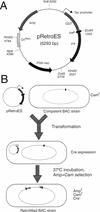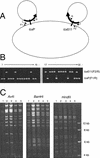An efficient method for high-fidelity BAC/PAC retrofitting with a selectable marker for mammalian cell transfection
- PMID: 11156622
- PMCID: PMC311050
- DOI: 10.1101/gr.159001
An efficient method for high-fidelity BAC/PAC retrofitting with a selectable marker for mammalian cell transfection
Abstract
Large-scale genomic sequencing projects have provided DNA sequence information for many genes, but the biological functions for most of them will only be known through functional studies. Bacterial artificial chromosomes (BACs) and P1-derived artificial chromosomes (PACs) are large genomic clones stably maintained in bacteria and are very important in functional studies through transfection because of their large size and stability. Because most BAC or PAC vectors do not have a mammalian selection marker, transfecting mammalian cells with genes cloned in BACs or PACs requires the insertion into the BAC/PAC of a mammalian selectable marker. However, currently available procedures are not satisfactory in efficiency and fidelity. We describe a very simple and efficient procedure that allows one to retrofit dozens of BACs in a day with no detectable deletions or unwanted recombination. We use a BAC/PAC retrofitting vector that, on transformation into competent BAC or PAC strains, will catalyze the specific insertion of itself into BAC/PAC vectors through in vivo cre/loxP site-specific recombination.
Figures


Similar articles
-
Isolating large nested deletions in bacterial and P1 artificial chromosomes by in vivo P1 packaging of products of Cre-catalysed recombination between the endogenous and a transposed loxP site.Nucleic Acids Res. 1997 Jun 1;25(11):2205-12. doi: 10.1093/nar/25.11.2205. Nucleic Acids Res. 1997. PMID: 9153322 Free PMC article.
-
Retrofitting vectors for Escherichia coli-based artificial chromosomes (PACs and BACs) with markers for transfection studies.Genome Res. 1997 Feb;7(2):179-86. doi: 10.1101/gr.7.2.179. Genome Res. 1997. PMID: 9049635
-
Simple and efficient vectors for retrofitting BACs and PACs with mammalian neoR and EGFP marker genes.Gene. 2001 Mar 21;266(1-2):147-53. doi: 10.1016/s0378-1119(01)00375-4. Gene. 2001. PMID: 11290429
-
YACs, BACs, PACs and MACs: artificial chromosomes as research tools.Trends Biotechnol. 1994 Jul;12(7):280-6. doi: 10.1016/0167-7799(94)90140-6. Trends Biotechnol. 1994. PMID: 7765076 Review.
-
[Advances and perspectives in artificial chromosomes].Yi Chuan. 2011 Apr;33(4):293-7. doi: 10.3724/sp.j.1005.2011.00293. Yi Chuan. 2011. PMID: 21482517 Review. Chinese.
Cited by
-
A novel genetic strategy reveals unexpected roles of the Swi-Snf-like chromatin-remodeling BAF complex in thymocyte development.J Exp Med. 2008 Nov 24;205(12):2813-25. doi: 10.1084/jem.20080938. Epub 2008 Oct 27. J Exp Med. 2008. PMID: 18955569 Free PMC article.
-
Replacing the wild type loxP site in BACs from the public domain with lox66 using a lox66 transposon.BMC Res Notes. 2010 Feb 19;3:38. doi: 10.1186/1756-0500-3-38. BMC Res Notes. 2010. PMID: 20170521 Free PMC article.
-
Retrofitting BACs with G418 resistance, luciferase, and oriP and EBNA-1 - new vectors for in vitro and in vivo delivery.BMC Biotechnol. 2003 Feb 3;3(1):2. doi: 10.1186/1472-6750-3-2. BMC Biotechnol. 2003. PMID: 12609052 Free PMC article.
-
Generating libraries of iTol2-end insertions at BAC ends using loxP and lox511 Tn10 transposons.BMC Genomics. 2011 Jul 7;12:351. doi: 10.1186/1471-2164-12-351. BMC Genomics. 2011. PMID: 21736732 Free PMC article.
-
Minimal cross-recombination between wild-type and loxP511 sites in vivo facilitates truncating both ends of large DNA inserts in pBACe3.6 and related vectors.Nucleic Acids Res. 2005 Aug 1;33(13):e118. doi: 10.1093/nar/gni119. Nucleic Acids Res. 2005. PMID: 16061933 Free PMC article.
References
-
- Bauchwitz R, Costantini F. YAC transgenesis: A study of conditions to protect YAC DNA from breakage and a protocol for transfection. Biochim Biophys Acta. 1998;1401:21–37. - PubMed
-
- Chatterjee PK, Sternberg NL. Retrofitting high molecular weight DNA cloned in P1: Introduction of reporter genes, markers selectable in mammalian cells and generation of nested deletions. Genet Anal. 1996;13:33–42. - PubMed
-
- Engler P, Storb U. A linkage map of distal mouse chromosome 4 in the vicinity of Ssm1, a strain-specific modifier of methylation. Mamm Genome. 2000;11:694–695. - PubMed
-
- Engler P, Haasch D, Pinkert CA, Doglio L, Glymour M, Brinster R, Storb U. A strain-specific modifier on mouse chromosome 4 controls the methylation of independent transgene loci. Cell. 1991;65:939–947. - PubMed
-
- Frengen E, Weichenhan D, Zhao B, Osoegawa K, van Geel M, de Jong PJ. A modular, positive selection bacterial artificial chromosome vector with multiple cloning sites. Genomics. 1999;58:250–253. - PubMed
Publication types
MeSH terms
Substances
Grants and funding
LinkOut - more resources
Full Text Sources
Other Literature Sources
